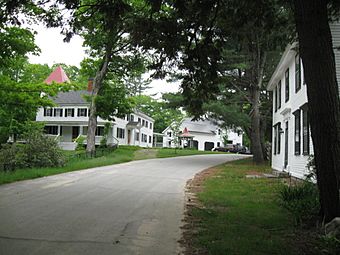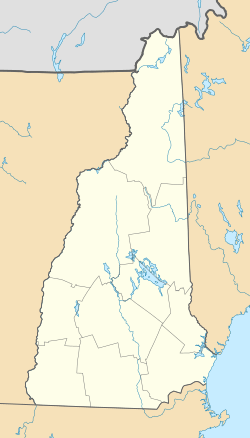Waterloo Historic District (Warner, New Hampshire) facts for kids
Quick facts for kids |
|
|
Waterloo Historic District
|
|
 |
|
| Location | 78-183 Waterloo St., 12 and 68 Newmarket Rd., 4 Willoughby-Colby Rd., Bean Road Cemetery, Warner, New Hampshire |
|---|---|
| Area | 50 acres (20 ha) |
| Built | 1791 |
| Architectural style | Georgian, Federal |
| NRHP reference No. | 03000926 |
| Added to NRHP | September 13, 2003 |
The Waterloo Historic District is a special area in Warner, New Hampshire. It's where one of the very first mills was built on the Warner River, near the beautiful Waterloo Falls. This district covers about 50 acres. It includes most of the original land given for the mill. The district stretches along Waterloo Street and Newmarket Street for about a mile. It's famous not just for its old mills, but also because two well-known politicians lived here: William E. Chandler and Nehemiah G. Ordway.
Contents
Exploring Waterloo's History
This part of Warner began to be settled in the 1770s. The first sawmill started working by 1789. The oldest house still standing in the district was built in 1791. It's a small, one-and-a-half-story house called a Cape style home. Many other houses in the area were built before 1820.
Homes of Famous People
Two important politicians lived in the Waterloo Historic District.
William E. Chandler's Home
William E. Chandler (1835-1917) was a very important person in American politics. He served as a United States Senator and as the United States Secretary of the Navy. He bought his house in 1872. This house was built in 1805. He also bought another house nearby, built in the 1820s. He used this second house for his staff when he had important guests visiting.
Nehemiah G. Ordway's Home
Nehemiah G. Ordway (1828-1907) was another famous politician. He was the seventh governor of the Dakota Territory. His house is at the corner of Newmarket and Waterloo streets. It was built in 1828. Later, in the early 1900s, it was updated to look like a "Colonial Revival" style home.
Old Buildings and Mills
Many old buildings have survived in the district. Most of them have been changed into homes.
The Bean Tavern
The Bean Tavern is a very old building. It was built in 1793 in a style called Georgian architecture.
Train Stations
Two buildings that used to be train stations are still here. One was built in 1849. It was moved a short distance to make room for the second station, which was built in 1910.
Chandler Mill
The main old factory building still standing is the Chandler Mill. It was built in 1836. The part of the mill that remains is two-and-a-half stories tall. It stands off Newmarket Street, between the railroad tracks and the river. You can also see parts of older mill foundations nearby.
Other Historic Spots
The district also has an old cemetery that dates back to 1815. There's also a small, one-room schoolhouse from around 1810.
Waterloo Covered Bridge
The district also includes the Waterloo Covered Bridge. This bridge is famous enough to be listed on its own. It carries Newmarket Street over the river.
The Waterloo Historic District was added to the National Register of Historic Places in 2003. This means it's recognized as an important place in American history.



